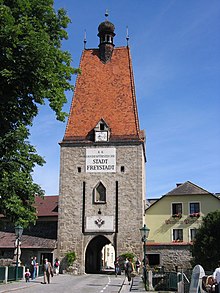Linzertor (Freistadt)
The listed Linzertor is a medieval city gate in Freistadt , Upper Austria . The name comes from the next larger city in the south - Linz . With its 28 m height, the Linzertor is one of the mightiest gate towers in Central Europe and is the city's landmark. The Linzertor has been adapted to the current architectural style several times over the years.
history
It was built in the 13th century at the southern entrance to the city (the Böhmertor is in the north ) and is therefore one of the oldest towers of the city fortifications. Around 1485 the builder Mathes Klayndl from Freistadt rebuilt the Linzertor in the late Gothic style. During this time, a bastion was raised in front of it, which can still be seen today on the property boundaries. In the baroque period , a baroque onion tower was placed on the top of the gable of the steep wedge roof of the Linzertor .
The outside of the city gate only protrudes a little from the course of the outer city wall . The old trade route from Enns to Bohemia , the later Reichsstraße (Linz - Prague) and then the federal highway 125 ran through the gate before a bypass road was built in the 1960s. In the Middle Ages, the gate was provided with a drawbridge , as evidenced by the long wall slots (for the swing beams). In peacetime the drawbridge remained on the ground, only the city gate was closed and locked when it was dark. The guard handed the key to the mayor overnight, and the gate was opened again at daybreak.
In 1964 and 1971, two safe passages for pedestrians were created to the right and left of the gate (through the outer city wall). This was necessary to give pedestrians safe access to the old town as the traffic through the gate increased steadily.
Today's appearance
Above the passage is an image of the patron saint of the city - Saint Catherine of Alexandria . The designation "kk = imperial-royal princely city of Freystadt" indicates that Freistadt belonged to the sovereign ( Babenberger , Habsburg since 1282 ), like seven other cities in Upper Austria. The southern and northern of the four roof bay windows have a stationary clock.
From the western pedestrian passage, a path leads into the Zwinger and on to the Schmidingerturm (Bürgererkorpsturm). The Zwinger is the space between the outer and inner city walls and is very well preserved in this area. In the past, the Zwinger was not allowed to be built on for security reasons. The only exception was that the city built a meat bank here and at the Böhmertor around 1570. After that, no more cattle could be slaughtered within the inner city wall; it was a sanitary measure and was supposed to help prevent disease.
literature
- Othmar Rappersberger: Freistadt - jewelry box of the Mühlviertel . Kunstverlag Hofstetter, Ried iI 1992
Web links
Coordinates: 48 ° 30 ′ 36 ″ N , 14 ° 30 ′ 10 ″ E



